Report on Planning and Implementation of a Coaching Strategy
VerifiedAdded on 2023/01/10
|18
|5517
|76
Report
AI Summary
This report provides a comprehensive analysis of coaching strategies, focusing on planning, implementation, and evaluation within an organizational context. It begins by exploring the sources of need for coaching, highlighting key components such as accountability, direction, and open communication. The report identifies the roles and responsibilities of stakeholders, including coaches, coachees, and managers, and examines various coaching models and methods like the GROW model. It delves into the legal and regulatory aspects of coaching programs and emphasizes the importance of matching coaches with trainees based on specific criteria. The report also covers professional development activities, monitoring coaching relationships, and presents a case study of Sim's Hardware, an Australian company, to illustrate the application of coaching strategies. The case study evaluates the current situation, identifies the need for a coaching program to address skill gaps, and outlines a detailed framework including resources, expected outcomes, interactive methods, and considerations for different learning styles. The report also emphasizes the roles and responsibilities of individuals involved in coaching and the scope of the coaching program's strategy for the organization.
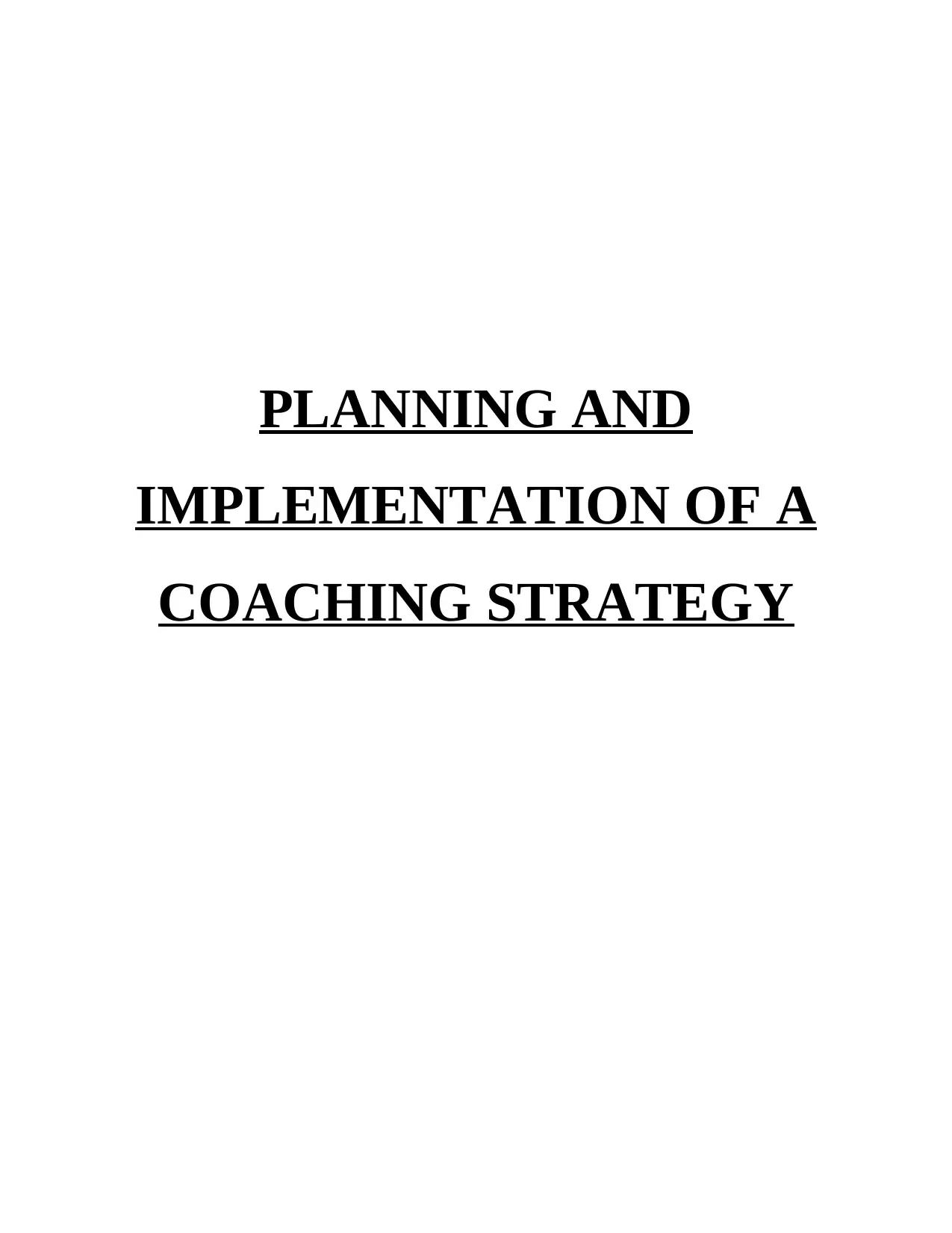
PLANNING AND
IMPLEMENTATION OF A
COACHING STRATEGY
IMPLEMENTATION OF A
COACHING STRATEGY
Paraphrase This Document
Need a fresh take? Get an instant paraphrase of this document with our AI Paraphraser
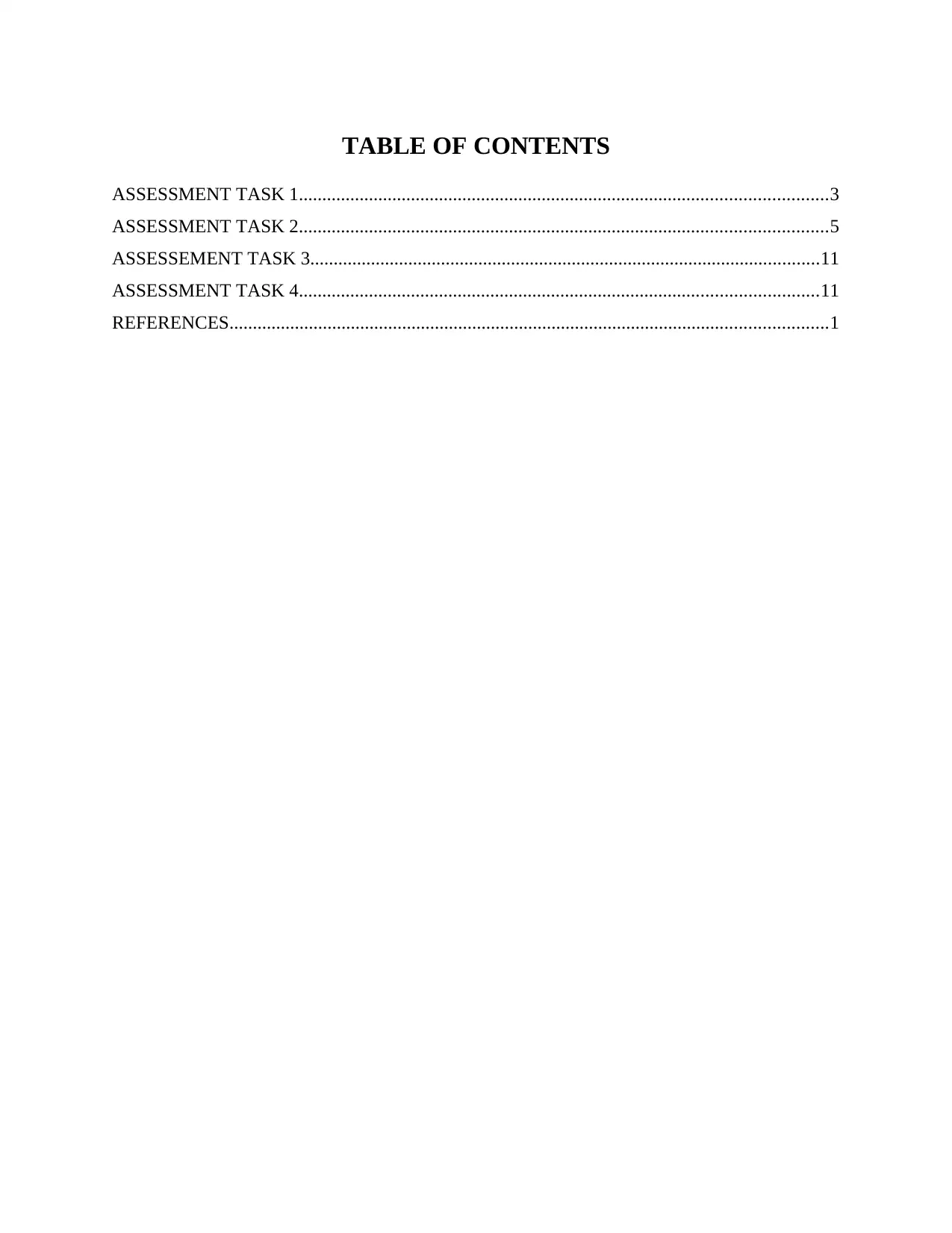
TABLE OF CONTENTS
ASSESSMENT TASK 1.................................................................................................................3
ASSESSMENT TASK 2.................................................................................................................5
ASSESSEMENT TASK 3.............................................................................................................11
ASSESSMENT TASK 4...............................................................................................................11
REFERENCES................................................................................................................................1
ASSESSMENT TASK 1.................................................................................................................3
ASSESSMENT TASK 2.................................................................................................................5
ASSESSEMENT TASK 3.............................................................................................................11
ASSESSMENT TASK 4...............................................................................................................11
REFERENCES................................................................................................................................1

ASSESSMENT TASK 1
1. Sources of need of coaching in an organization:
There are many ways through which the organization realizes the need for coaching.
Scottish Social Services Council realized its need when the strategies they made, didn't
contribute positively in the overall progress of the firm. So, they felt that the employees are not
enough skilled to plan good strategies. So, they thought of starting coaching programme.
2. Components of coaching strategy:
The key components of the coaching in organization are as follows:
Accountability: It makes them responsible to account their own errors and actions.
Direction: Before providing coaching to employees, coach should make the organisational goals
clear in their mind and also direct them accordingly.
Openness: it includes the open communication, which means the sense of transparency at
organizational level.
Leadership quality: It helps an individual in leading the team by being in the team.
Therefore, it helps individual to develop their own skills.
3. Responsible person for the roles and responsibility of the coaching program:
the people who are responsible for the coaching programs are: coaches, who trains the
employees, coachee, who takes the training from coach, the manager, who arranges the coaching
for the members.
4. The role of the coach:
The coach plays many roles, they are:
A coach should maintain clear communication and focussed goals with the employees. They
encourage them in learning new things and explore, they also provide regular feedback to the
employees and make them correct if needed. Good coaches use different types of activities such
as quiz etc. during the meeting. A coach knows all the weakness and strength of an individual,
then works upon the weaknesses and motivate to convert weakness into strength.
5. The stakeholders are helpful in developing the coaching strategy:
The five stakeholders that helps in developing the timeline of coaching strategies are as
follows:
1. Sources of need of coaching in an organization:
There are many ways through which the organization realizes the need for coaching.
Scottish Social Services Council realized its need when the strategies they made, didn't
contribute positively in the overall progress of the firm. So, they felt that the employees are not
enough skilled to plan good strategies. So, they thought of starting coaching programme.
2. Components of coaching strategy:
The key components of the coaching in organization are as follows:
Accountability: It makes them responsible to account their own errors and actions.
Direction: Before providing coaching to employees, coach should make the organisational goals
clear in their mind and also direct them accordingly.
Openness: it includes the open communication, which means the sense of transparency at
organizational level.
Leadership quality: It helps an individual in leading the team by being in the team.
Therefore, it helps individual to develop their own skills.
3. Responsible person for the roles and responsibility of the coaching program:
the people who are responsible for the coaching programs are: coaches, who trains the
employees, coachee, who takes the training from coach, the manager, who arranges the coaching
for the members.
4. The role of the coach:
The coach plays many roles, they are:
A coach should maintain clear communication and focussed goals with the employees. They
encourage them in learning new things and explore, they also provide regular feedback to the
employees and make them correct if needed. Good coaches use different types of activities such
as quiz etc. during the meeting. A coach knows all the weakness and strength of an individual,
then works upon the weaknesses and motivate to convert weakness into strength.
5. The stakeholders are helpful in developing the coaching strategy:
The five stakeholders that helps in developing the timeline of coaching strategies are as
follows:
⊘ This is a preview!⊘
Do you want full access?
Subscribe today to unlock all pages.

Trusted by 1+ million students worldwide
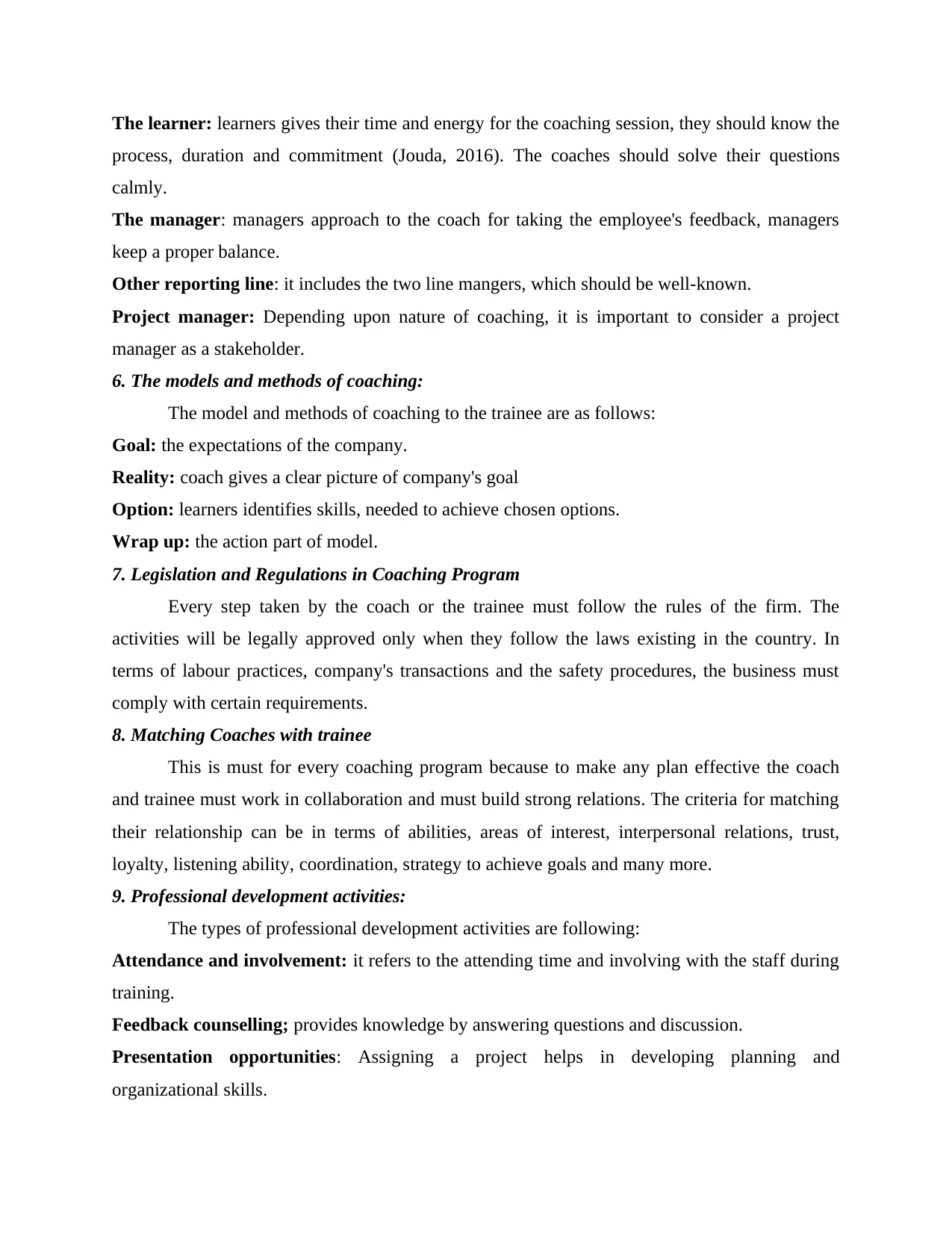
The learner: learners gives their time and energy for the coaching session, they should know the
process, duration and commitment (Jouda, 2016). The coaches should solve their questions
calmly.
The manager: managers approach to the coach for taking the employee's feedback, managers
keep a proper balance.
Other reporting line: it includes the two line mangers, which should be well-known.
Project manager: Depending upon nature of coaching, it is important to consider a project
manager as a stakeholder.
6. The models and methods of coaching:
The model and methods of coaching to the trainee are as follows:
Goal: the expectations of the company.
Reality: coach gives a clear picture of company's goal
Option: learners identifies skills, needed to achieve chosen options.
Wrap up: the action part of model.
7. Legislation and Regulations in Coaching Program
Every step taken by the coach or the trainee must follow the rules of the firm. The
activities will be legally approved only when they follow the laws existing in the country. In
terms of labour practices, company's transactions and the safety procedures, the business must
comply with certain requirements.
8. Matching Coaches with trainee
This is must for every coaching program because to make any plan effective the coach
and trainee must work in collaboration and must build strong relations. The criteria for matching
their relationship can be in terms of abilities, areas of interest, interpersonal relations, trust,
loyalty, listening ability, coordination, strategy to achieve goals and many more.
9. Professional development activities:
The types of professional development activities are following:
Attendance and involvement: it refers to the attending time and involving with the staff during
training.
Feedback counselling; provides knowledge by answering questions and discussion.
Presentation opportunities: Assigning a project helps in developing planning and
organizational skills.
process, duration and commitment (Jouda, 2016). The coaches should solve their questions
calmly.
The manager: managers approach to the coach for taking the employee's feedback, managers
keep a proper balance.
Other reporting line: it includes the two line mangers, which should be well-known.
Project manager: Depending upon nature of coaching, it is important to consider a project
manager as a stakeholder.
6. The models and methods of coaching:
The model and methods of coaching to the trainee are as follows:
Goal: the expectations of the company.
Reality: coach gives a clear picture of company's goal
Option: learners identifies skills, needed to achieve chosen options.
Wrap up: the action part of model.
7. Legislation and Regulations in Coaching Program
Every step taken by the coach or the trainee must follow the rules of the firm. The
activities will be legally approved only when they follow the laws existing in the country. In
terms of labour practices, company's transactions and the safety procedures, the business must
comply with certain requirements.
8. Matching Coaches with trainee
This is must for every coaching program because to make any plan effective the coach
and trainee must work in collaboration and must build strong relations. The criteria for matching
their relationship can be in terms of abilities, areas of interest, interpersonal relations, trust,
loyalty, listening ability, coordination, strategy to achieve goals and many more.
9. Professional development activities:
The types of professional development activities are following:
Attendance and involvement: it refers to the attending time and involving with the staff during
training.
Feedback counselling; provides knowledge by answering questions and discussion.
Presentation opportunities: Assigning a project helps in developing planning and
organizational skills.
Paraphrase This Document
Need a fresh take? Get an instant paraphrase of this document with our AI Paraphraser
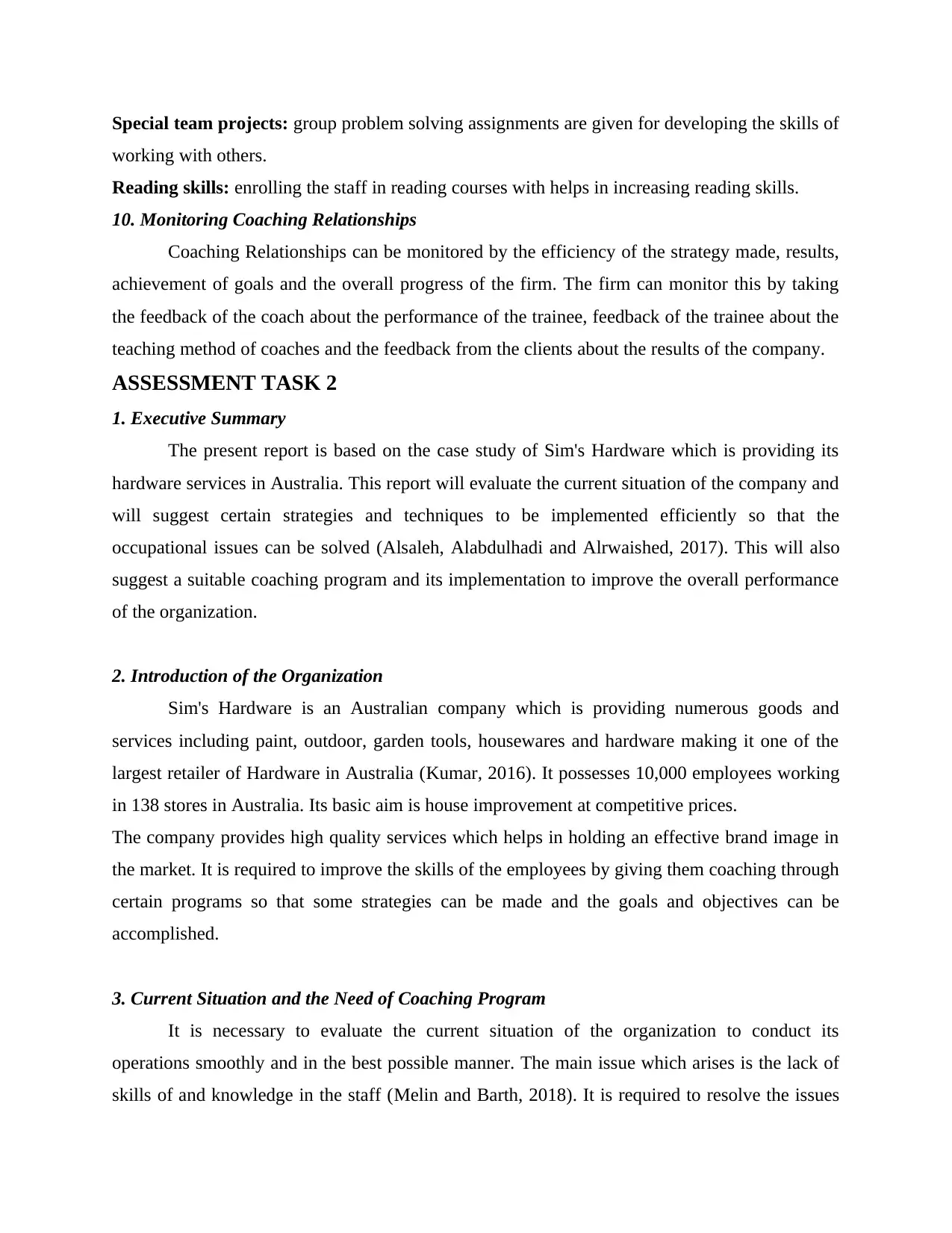
Special team projects: group problem solving assignments are given for developing the skills of
working with others.
Reading skills: enrolling the staff in reading courses with helps in increasing reading skills.
10. Monitoring Coaching Relationships
Coaching Relationships can be monitored by the efficiency of the strategy made, results,
achievement of goals and the overall progress of the firm. The firm can monitor this by taking
the feedback of the coach about the performance of the trainee, feedback of the trainee about the
teaching method of coaches and the feedback from the clients about the results of the company.
ASSESSMENT TASK 2
1. Executive Summary
The present report is based on the case study of Sim's Hardware which is providing its
hardware services in Australia. This report will evaluate the current situation of the company and
will suggest certain strategies and techniques to be implemented efficiently so that the
occupational issues can be solved (Alsaleh, Alabdulhadi and Alrwaished, 2017). This will also
suggest a suitable coaching program and its implementation to improve the overall performance
of the organization.
2. Introduction of the Organization
Sim's Hardware is an Australian company which is providing numerous goods and
services including paint, outdoor, garden tools, housewares and hardware making it one of the
largest retailer of Hardware in Australia (Kumar, 2016). It possesses 10,000 employees working
in 138 stores in Australia. Its basic aim is house improvement at competitive prices.
The company provides high quality services which helps in holding an effective brand image in
the market. It is required to improve the skills of the employees by giving them coaching through
certain programs so that some strategies can be made and the goals and objectives can be
accomplished.
3. Current Situation and the Need of Coaching Program
It is necessary to evaluate the current situation of the organization to conduct its
operations smoothly and in the best possible manner. The main issue which arises is the lack of
skills of and knowledge in the staff (Melin and Barth, 2018). It is required to resolve the issues
working with others.
Reading skills: enrolling the staff in reading courses with helps in increasing reading skills.
10. Monitoring Coaching Relationships
Coaching Relationships can be monitored by the efficiency of the strategy made, results,
achievement of goals and the overall progress of the firm. The firm can monitor this by taking
the feedback of the coach about the performance of the trainee, feedback of the trainee about the
teaching method of coaches and the feedback from the clients about the results of the company.
ASSESSMENT TASK 2
1. Executive Summary
The present report is based on the case study of Sim's Hardware which is providing its
hardware services in Australia. This report will evaluate the current situation of the company and
will suggest certain strategies and techniques to be implemented efficiently so that the
occupational issues can be solved (Alsaleh, Alabdulhadi and Alrwaished, 2017). This will also
suggest a suitable coaching program and its implementation to improve the overall performance
of the organization.
2. Introduction of the Organization
Sim's Hardware is an Australian company which is providing numerous goods and
services including paint, outdoor, garden tools, housewares and hardware making it one of the
largest retailer of Hardware in Australia (Kumar, 2016). It possesses 10,000 employees working
in 138 stores in Australia. Its basic aim is house improvement at competitive prices.
The company provides high quality services which helps in holding an effective brand image in
the market. It is required to improve the skills of the employees by giving them coaching through
certain programs so that some strategies can be made and the goals and objectives can be
accomplished.
3. Current Situation and the Need of Coaching Program
It is necessary to evaluate the current situation of the organization to conduct its
operations smoothly and in the best possible manner. The main issue which arises is the lack of
skills of and knowledge in the staff (Melin and Barth, 2018). It is required to resolve the issues

identifies in proper manner so that long term performance of the firm can be easily manageable
and can bring favourable results.
Presently, the hired workforce in Sim's Hardware does not possess right skills and knowledge.
So, this becomes a major challenge for the firm to introduce certain coaching programs because
it is facing lot of issues which is creating barriers in satisfying the overall needs of the
competitive market. There is a need to train the employees so that they can make strategies to
achieve the goal of the firm.
4. Detailed Framework
A. Context and Needs of the Organization
The purpose of coaching in the workplace is to improve the skills of the employees either
by enhancing the current ones or by acquiring the new ones (van Nieuwerburgh and Passmore,
2018). Following are the reasons of implementing coaching program in Sim's Hardware :
The firm is seeking to develop its employees in specific competencies or skills.
It has talented employees but are not skilled to achieve the target goals.
The firm wants to make some changes in the existing system and to introduce a new system.
The leader of the firm needs assistance in acquiring new skill as an additional responsibility.
The great way to achieve the above mentioned factors is to spread the firm with coaching role
models by rolling out an initial training programme on its benefits and methods. The initial thing
required before coaching is to choose a leader who can be role model, supporters and sustained
of coaching mind-set and also able to train the employees to make new strategies.
B. Required Resources
When the firm decides to provide training to the employees by coaching programs then it
needs certain resources for its implementation. In Sim's Hardware, the main thing to be focussed
before starting of a coaching programme is to identify the objective of the program. It will help
to choose the further things including the coach, place, materials etc. then, comes the decision to
choose a well-trained coach (Stout-Rostron, 2018). The coach must be aware of all the objectives
of the firm and must be expertize in that area. So, it is must giving initial training to the coach
also to make him comfortable with the targets of the firm. Then another thing needed is the
schedule for coaching according to both the employees and the coach which does not become
and can bring favourable results.
Presently, the hired workforce in Sim's Hardware does not possess right skills and knowledge.
So, this becomes a major challenge for the firm to introduce certain coaching programs because
it is facing lot of issues which is creating barriers in satisfying the overall needs of the
competitive market. There is a need to train the employees so that they can make strategies to
achieve the goal of the firm.
4. Detailed Framework
A. Context and Needs of the Organization
The purpose of coaching in the workplace is to improve the skills of the employees either
by enhancing the current ones or by acquiring the new ones (van Nieuwerburgh and Passmore,
2018). Following are the reasons of implementing coaching program in Sim's Hardware :
The firm is seeking to develop its employees in specific competencies or skills.
It has talented employees but are not skilled to achieve the target goals.
The firm wants to make some changes in the existing system and to introduce a new system.
The leader of the firm needs assistance in acquiring new skill as an additional responsibility.
The great way to achieve the above mentioned factors is to spread the firm with coaching role
models by rolling out an initial training programme on its benefits and methods. The initial thing
required before coaching is to choose a leader who can be role model, supporters and sustained
of coaching mind-set and also able to train the employees to make new strategies.
B. Required Resources
When the firm decides to provide training to the employees by coaching programs then it
needs certain resources for its implementation. In Sim's Hardware, the main thing to be focussed
before starting of a coaching programme is to identify the objective of the program. It will help
to choose the further things including the coach, place, materials etc. then, comes the decision to
choose a well-trained coach (Stout-Rostron, 2018). The coach must be aware of all the objectives
of the firm and must be expertize in that area. So, it is must giving initial training to the coach
also to make him comfortable with the targets of the firm. Then another thing needed is the
schedule for coaching according to both the employees and the coach which does not become
⊘ This is a preview!⊘
Do you want full access?
Subscribe today to unlock all pages.

Trusted by 1+ million students worldwide
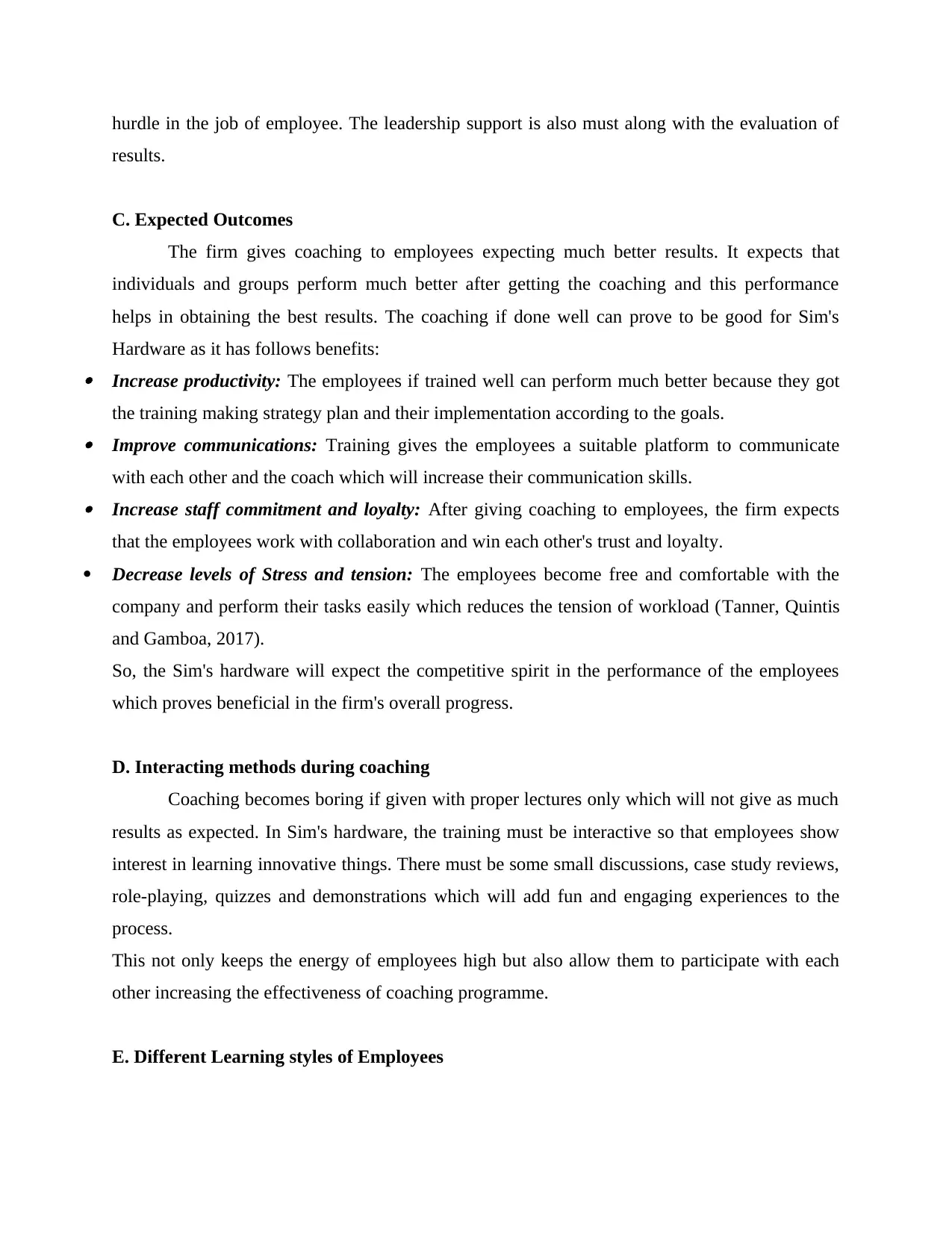
hurdle in the job of employee. The leadership support is also must along with the evaluation of
results.
C. Expected Outcomes
The firm gives coaching to employees expecting much better results. It expects that
individuals and groups perform much better after getting the coaching and this performance
helps in obtaining the best results. The coaching if done well can prove to be good for Sim's
Hardware as it has follows benefits:
Increase productivity: The employees if trained well can perform much better because they got
the training making strategy plan and their implementation according to the goals.
Improve communications: Training gives the employees a suitable platform to communicate
with each other and the coach which will increase their communication skills.
Increase staff commitment and loyalty: After giving coaching to employees, the firm expects
that the employees work with collaboration and win each other's trust and loyalty.
Decrease levels of Stress and tension: The employees become free and comfortable with the
company and perform their tasks easily which reduces the tension of workload (Tanner, Quintis
and Gamboa, 2017).
So, the Sim's hardware will expect the competitive spirit in the performance of the employees
which proves beneficial in the firm's overall progress.
D. Interacting methods during coaching
Coaching becomes boring if given with proper lectures only which will not give as much
results as expected. In Sim's hardware, the training must be interactive so that employees show
interest in learning innovative things. There must be some small discussions, case study reviews,
role-playing, quizzes and demonstrations which will add fun and engaging experiences to the
process.
This not only keeps the energy of employees high but also allow them to participate with each
other increasing the effectiveness of coaching programme.
E. Different Learning styles of Employees
results.
C. Expected Outcomes
The firm gives coaching to employees expecting much better results. It expects that
individuals and groups perform much better after getting the coaching and this performance
helps in obtaining the best results. The coaching if done well can prove to be good for Sim's
Hardware as it has follows benefits:
Increase productivity: The employees if trained well can perform much better because they got
the training making strategy plan and their implementation according to the goals.
Improve communications: Training gives the employees a suitable platform to communicate
with each other and the coach which will increase their communication skills.
Increase staff commitment and loyalty: After giving coaching to employees, the firm expects
that the employees work with collaboration and win each other's trust and loyalty.
Decrease levels of Stress and tension: The employees become free and comfortable with the
company and perform their tasks easily which reduces the tension of workload (Tanner, Quintis
and Gamboa, 2017).
So, the Sim's hardware will expect the competitive spirit in the performance of the employees
which proves beneficial in the firm's overall progress.
D. Interacting methods during coaching
Coaching becomes boring if given with proper lectures only which will not give as much
results as expected. In Sim's hardware, the training must be interactive so that employees show
interest in learning innovative things. There must be some small discussions, case study reviews,
role-playing, quizzes and demonstrations which will add fun and engaging experiences to the
process.
This not only keeps the energy of employees high but also allow them to participate with each
other increasing the effectiveness of coaching programme.
E. Different Learning styles of Employees
Paraphrase This Document
Need a fresh take? Get an instant paraphrase of this document with our AI Paraphraser
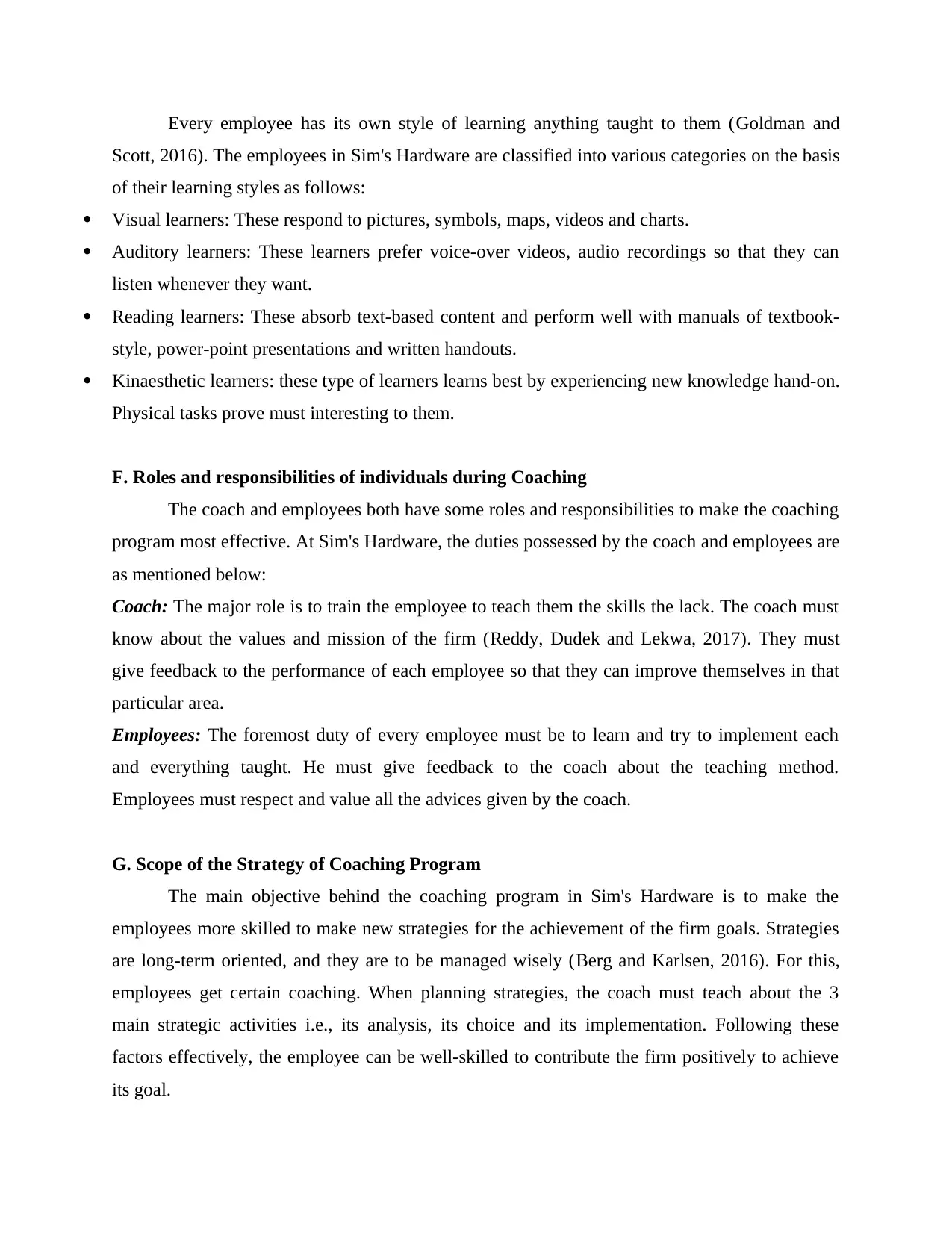
Every employee has its own style of learning anything taught to them (Goldman and
Scott, 2016). The employees in Sim's Hardware are classified into various categories on the basis
of their learning styles as follows:
Visual learners: These respond to pictures, symbols, maps, videos and charts.
Auditory learners: These learners prefer voice-over videos, audio recordings so that they can
listen whenever they want.
Reading learners: These absorb text-based content and perform well with manuals of textbook-
style, power-point presentations and written handouts.
Kinaesthetic learners: these type of learners learns best by experiencing new knowledge hand-on.
Physical tasks prove must interesting to them.
F. Roles and responsibilities of individuals during Coaching
The coach and employees both have some roles and responsibilities to make the coaching
program most effective. At Sim's Hardware, the duties possessed by the coach and employees are
as mentioned below:
Coach: The major role is to train the employee to teach them the skills the lack. The coach must
know about the values and mission of the firm (Reddy, Dudek and Lekwa, 2017). They must
give feedback to the performance of each employee so that they can improve themselves in that
particular area.
Employees: The foremost duty of every employee must be to learn and try to implement each
and everything taught. He must give feedback to the coach about the teaching method.
Employees must respect and value all the advices given by the coach.
G. Scope of the Strategy of Coaching Program
The main objective behind the coaching program in Sim's Hardware is to make the
employees more skilled to make new strategies for the achievement of the firm goals. Strategies
are long-term oriented, and they are to be managed wisely (Berg and Karlsen, 2016). For this,
employees get certain coaching. When planning strategies, the coach must teach about the 3
main strategic activities i.e., its analysis, its choice and its implementation. Following these
factors effectively, the employee can be well-skilled to contribute the firm positively to achieve
its goal.
Scott, 2016). The employees in Sim's Hardware are classified into various categories on the basis
of their learning styles as follows:
Visual learners: These respond to pictures, symbols, maps, videos and charts.
Auditory learners: These learners prefer voice-over videos, audio recordings so that they can
listen whenever they want.
Reading learners: These absorb text-based content and perform well with manuals of textbook-
style, power-point presentations and written handouts.
Kinaesthetic learners: these type of learners learns best by experiencing new knowledge hand-on.
Physical tasks prove must interesting to them.
F. Roles and responsibilities of individuals during Coaching
The coach and employees both have some roles and responsibilities to make the coaching
program most effective. At Sim's Hardware, the duties possessed by the coach and employees are
as mentioned below:
Coach: The major role is to train the employee to teach them the skills the lack. The coach must
know about the values and mission of the firm (Reddy, Dudek and Lekwa, 2017). They must
give feedback to the performance of each employee so that they can improve themselves in that
particular area.
Employees: The foremost duty of every employee must be to learn and try to implement each
and everything taught. He must give feedback to the coach about the teaching method.
Employees must respect and value all the advices given by the coach.
G. Scope of the Strategy of Coaching Program
The main objective behind the coaching program in Sim's Hardware is to make the
employees more skilled to make new strategies for the achievement of the firm goals. Strategies
are long-term oriented, and they are to be managed wisely (Berg and Karlsen, 2016). For this,
employees get certain coaching. When planning strategies, the coach must teach about the 3
main strategic activities i.e., its analysis, its choice and its implementation. Following these
factors effectively, the employee can be well-skilled to contribute the firm positively to achieve
its goal.

H. Support of Organization to its procedures
Starting of a coaching programme is not the decision of an individual in a firm, in Sim's
hardware also, if they want to start trainings then every pillar of it must support this decision
because if any authority is against of it, then it becomes a hurdle in obtaining good results ( Carr,
Holmes and Flynn, 2017). Every authority of the firm must give their contribution to make the
coaching program successful.
5. Timelines for coaching strategy implementation
Time plays a significant role in the context of organizations. When the strategies come I
play, then it is the time of its implementation which decides the effectiveness and contribution of
it to the firm's goal. Because, the market changes regularly and the strategies should also change
accordingly. Sim's hardware must focus on the timeline and give the deadline to the coach for
each strategy and its implementation.
If in case, in one month, the market demand is for new products and the strategy of introducing
new product is implemented in the next month then it doesn't contribute the firm in any way but
the waste of time, money and resources. So, the firm must give a deadline to make and
implement a strategy for improvement of overall progress it.
6. Induction, Design and Training Tools & Resources
Induction of both the trainee and the coaches is necessary as this must not be completed
once but must be ongoing. Sim's hardware must focus on the time given to the coach to clarify
goals of the firm along with providing them tips to stay on the track or to improve at particular
area. Likewise, employees must be given time to engage with the coaches so that the goals and
aim can be discussed along with meeting the expectations.
7. Recruitment process
Recruiting process in Sim's Hardware must be efficient for both the trainees and the
coaches as follows:
Starting of a coaching programme is not the decision of an individual in a firm, in Sim's
hardware also, if they want to start trainings then every pillar of it must support this decision
because if any authority is against of it, then it becomes a hurdle in obtaining good results ( Carr,
Holmes and Flynn, 2017). Every authority of the firm must give their contribution to make the
coaching program successful.
5. Timelines for coaching strategy implementation
Time plays a significant role in the context of organizations. When the strategies come I
play, then it is the time of its implementation which decides the effectiveness and contribution of
it to the firm's goal. Because, the market changes regularly and the strategies should also change
accordingly. Sim's hardware must focus on the timeline and give the deadline to the coach for
each strategy and its implementation.
If in case, in one month, the market demand is for new products and the strategy of introducing
new product is implemented in the next month then it doesn't contribute the firm in any way but
the waste of time, money and resources. So, the firm must give a deadline to make and
implement a strategy for improvement of overall progress it.
6. Induction, Design and Training Tools & Resources
Induction of both the trainee and the coaches is necessary as this must not be completed
once but must be ongoing. Sim's hardware must focus on the time given to the coach to clarify
goals of the firm along with providing them tips to stay on the track or to improve at particular
area. Likewise, employees must be given time to engage with the coaches so that the goals and
aim can be discussed along with meeting the expectations.
7. Recruitment process
Recruiting process in Sim's Hardware must be efficient for both the trainees and the
coaches as follows:
⊘ This is a preview!⊘
Do you want full access?
Subscribe today to unlock all pages.

Trusted by 1+ million students worldwide
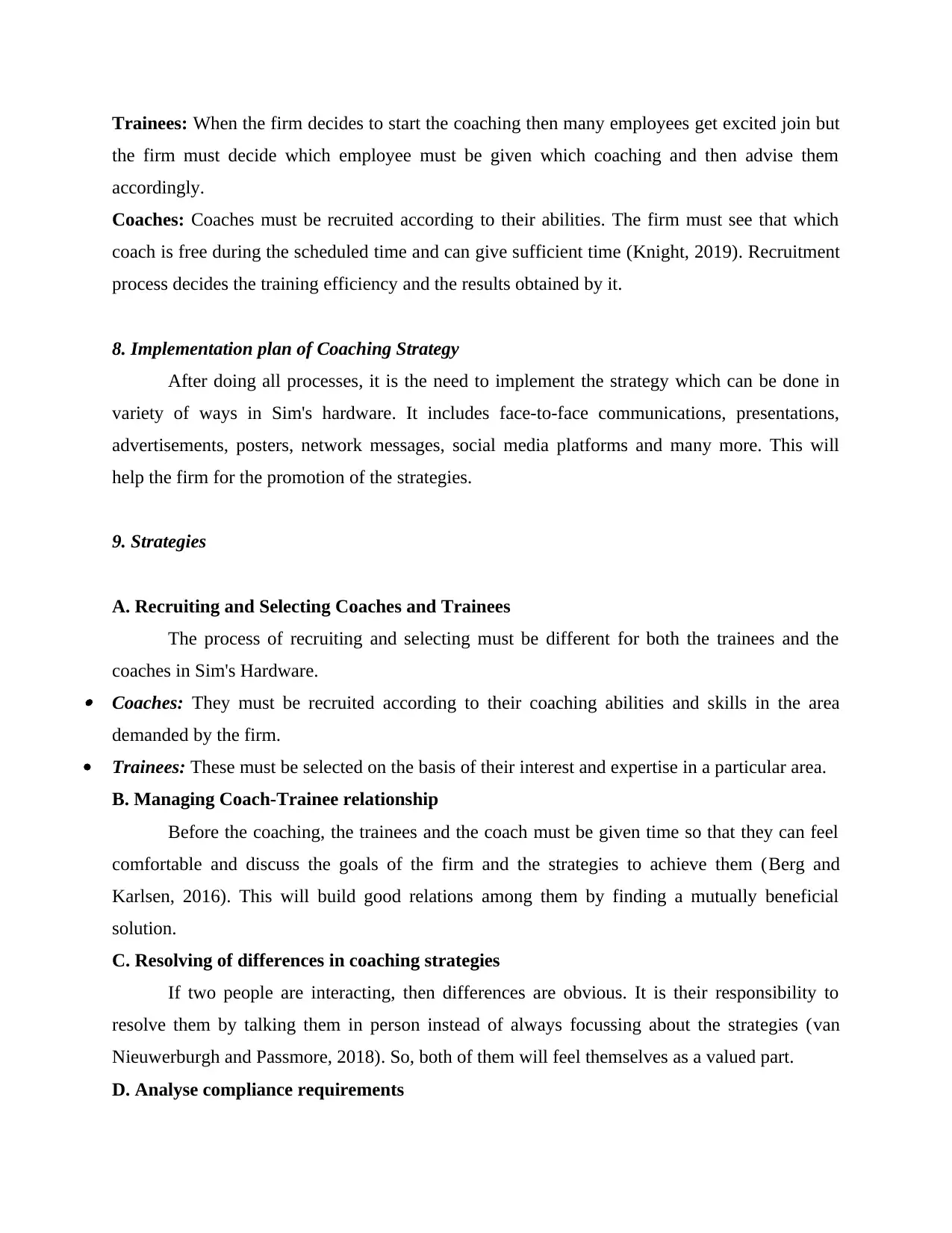
Trainees: When the firm decides to start the coaching then many employees get excited join but
the firm must decide which employee must be given which coaching and then advise them
accordingly.
Coaches: Coaches must be recruited according to their abilities. The firm must see that which
coach is free during the scheduled time and can give sufficient time (Knight, 2019). Recruitment
process decides the training efficiency and the results obtained by it.
8. Implementation plan of Coaching Strategy
After doing all processes, it is the need to implement the strategy which can be done in
variety of ways in Sim's hardware. It includes face-to-face communications, presentations,
advertisements, posters, network messages, social media platforms and many more. This will
help the firm for the promotion of the strategies.
9. Strategies
A. Recruiting and Selecting Coaches and Trainees
The process of recruiting and selecting must be different for both the trainees and the
coaches in Sim's Hardware.
Coaches: They must be recruited according to their coaching abilities and skills in the area
demanded by the firm.
Trainees: These must be selected on the basis of their interest and expertise in a particular area.
B. Managing Coach-Trainee relationship
Before the coaching, the trainees and the coach must be given time so that they can feel
comfortable and discuss the goals of the firm and the strategies to achieve them (Berg and
Karlsen, 2016). This will build good relations among them by finding a mutually beneficial
solution.
C. Resolving of differences in coaching strategies
If two people are interacting, then differences are obvious. It is their responsibility to
resolve them by talking them in person instead of always focussing about the strategies (van
Nieuwerburgh and Passmore, 2018). So, both of them will feel themselves as a valued part.
D. Analyse compliance requirements
the firm must decide which employee must be given which coaching and then advise them
accordingly.
Coaches: Coaches must be recruited according to their abilities. The firm must see that which
coach is free during the scheduled time and can give sufficient time (Knight, 2019). Recruitment
process decides the training efficiency and the results obtained by it.
8. Implementation plan of Coaching Strategy
After doing all processes, it is the need to implement the strategy which can be done in
variety of ways in Sim's hardware. It includes face-to-face communications, presentations,
advertisements, posters, network messages, social media platforms and many more. This will
help the firm for the promotion of the strategies.
9. Strategies
A. Recruiting and Selecting Coaches and Trainees
The process of recruiting and selecting must be different for both the trainees and the
coaches in Sim's Hardware.
Coaches: They must be recruited according to their coaching abilities and skills in the area
demanded by the firm.
Trainees: These must be selected on the basis of their interest and expertise in a particular area.
B. Managing Coach-Trainee relationship
Before the coaching, the trainees and the coach must be given time so that they can feel
comfortable and discuss the goals of the firm and the strategies to achieve them (Berg and
Karlsen, 2016). This will build good relations among them by finding a mutually beneficial
solution.
C. Resolving of differences in coaching strategies
If two people are interacting, then differences are obvious. It is their responsibility to
resolve them by talking them in person instead of always focussing about the strategies (van
Nieuwerburgh and Passmore, 2018). So, both of them will feel themselves as a valued part.
D. Analyse compliance requirements
Paraphrase This Document
Need a fresh take? Get an instant paraphrase of this document with our AI Paraphraser
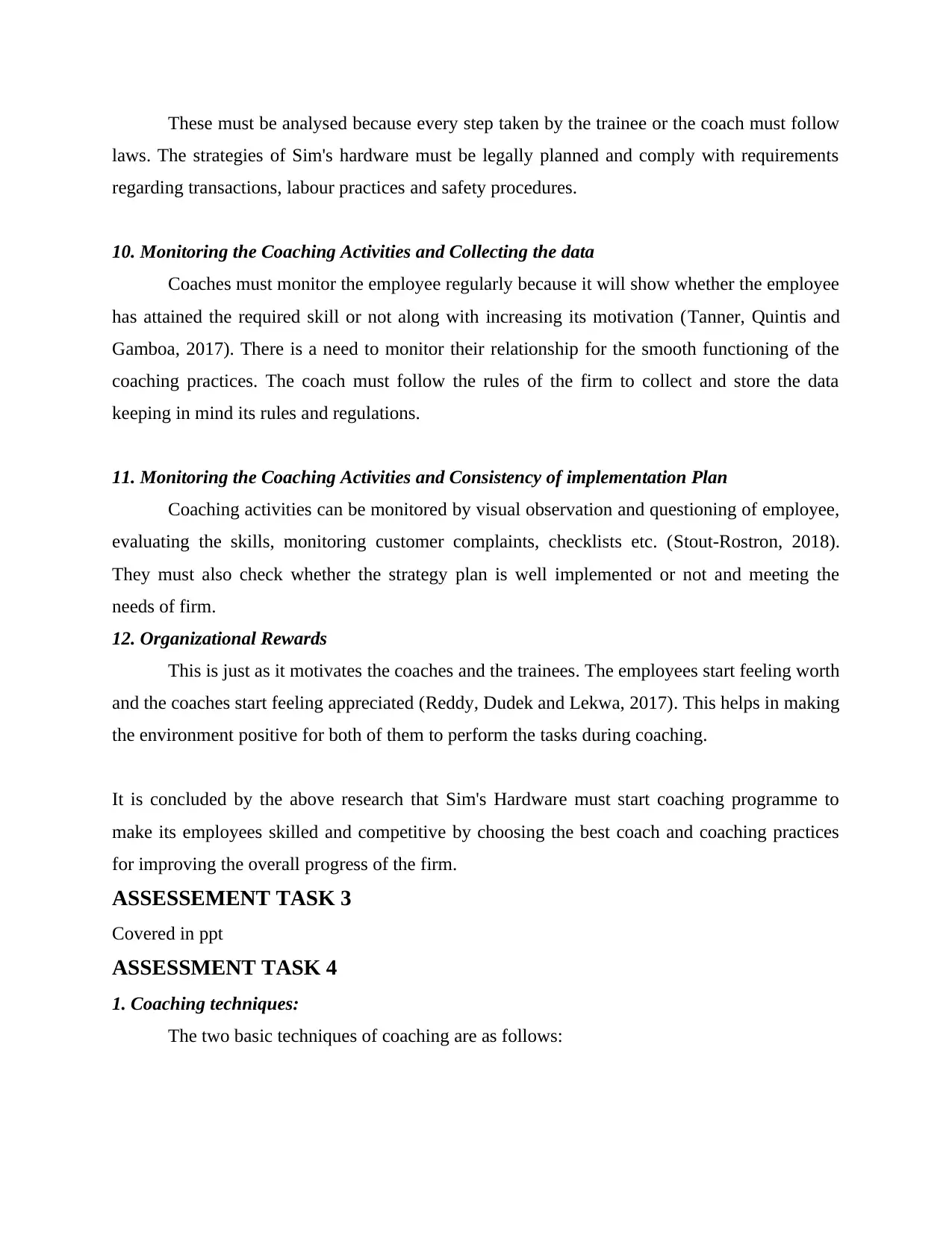
These must be analysed because every step taken by the trainee or the coach must follow
laws. The strategies of Sim's hardware must be legally planned and comply with requirements
regarding transactions, labour practices and safety procedures.
10. Monitoring the Coaching Activities and Collecting the data
Coaches must monitor the employee regularly because it will show whether the employee
has attained the required skill or not along with increasing its motivation (Tanner, Quintis and
Gamboa, 2017). There is a need to monitor their relationship for the smooth functioning of the
coaching practices. The coach must follow the rules of the firm to collect and store the data
keeping in mind its rules and regulations.
11. Monitoring the Coaching Activities and Consistency of implementation Plan
Coaching activities can be monitored by visual observation and questioning of employee,
evaluating the skills, monitoring customer complaints, checklists etc. (Stout-Rostron, 2018).
They must also check whether the strategy plan is well implemented or not and meeting the
needs of firm.
12. Organizational Rewards
This is just as it motivates the coaches and the trainees. The employees start feeling worth
and the coaches start feeling appreciated (Reddy, Dudek and Lekwa, 2017). This helps in making
the environment positive for both of them to perform the tasks during coaching.
It is concluded by the above research that Sim's Hardware must start coaching programme to
make its employees skilled and competitive by choosing the best coach and coaching practices
for improving the overall progress of the firm.
ASSESSEMENT TASK 3
Covered in ppt
ASSESSMENT TASK 4
1. Coaching techniques:
The two basic techniques of coaching are as follows:
laws. The strategies of Sim's hardware must be legally planned and comply with requirements
regarding transactions, labour practices and safety procedures.
10. Monitoring the Coaching Activities and Collecting the data
Coaches must monitor the employee regularly because it will show whether the employee
has attained the required skill or not along with increasing its motivation (Tanner, Quintis and
Gamboa, 2017). There is a need to monitor their relationship for the smooth functioning of the
coaching practices. The coach must follow the rules of the firm to collect and store the data
keeping in mind its rules and regulations.
11. Monitoring the Coaching Activities and Consistency of implementation Plan
Coaching activities can be monitored by visual observation and questioning of employee,
evaluating the skills, monitoring customer complaints, checklists etc. (Stout-Rostron, 2018).
They must also check whether the strategy plan is well implemented or not and meeting the
needs of firm.
12. Organizational Rewards
This is just as it motivates the coaches and the trainees. The employees start feeling worth
and the coaches start feeling appreciated (Reddy, Dudek and Lekwa, 2017). This helps in making
the environment positive for both of them to perform the tasks during coaching.
It is concluded by the above research that Sim's Hardware must start coaching programme to
make its employees skilled and competitive by choosing the best coach and coaching practices
for improving the overall progress of the firm.
ASSESSEMENT TASK 3
Covered in ppt
ASSESSMENT TASK 4
1. Coaching techniques:
The two basic techniques of coaching are as follows:
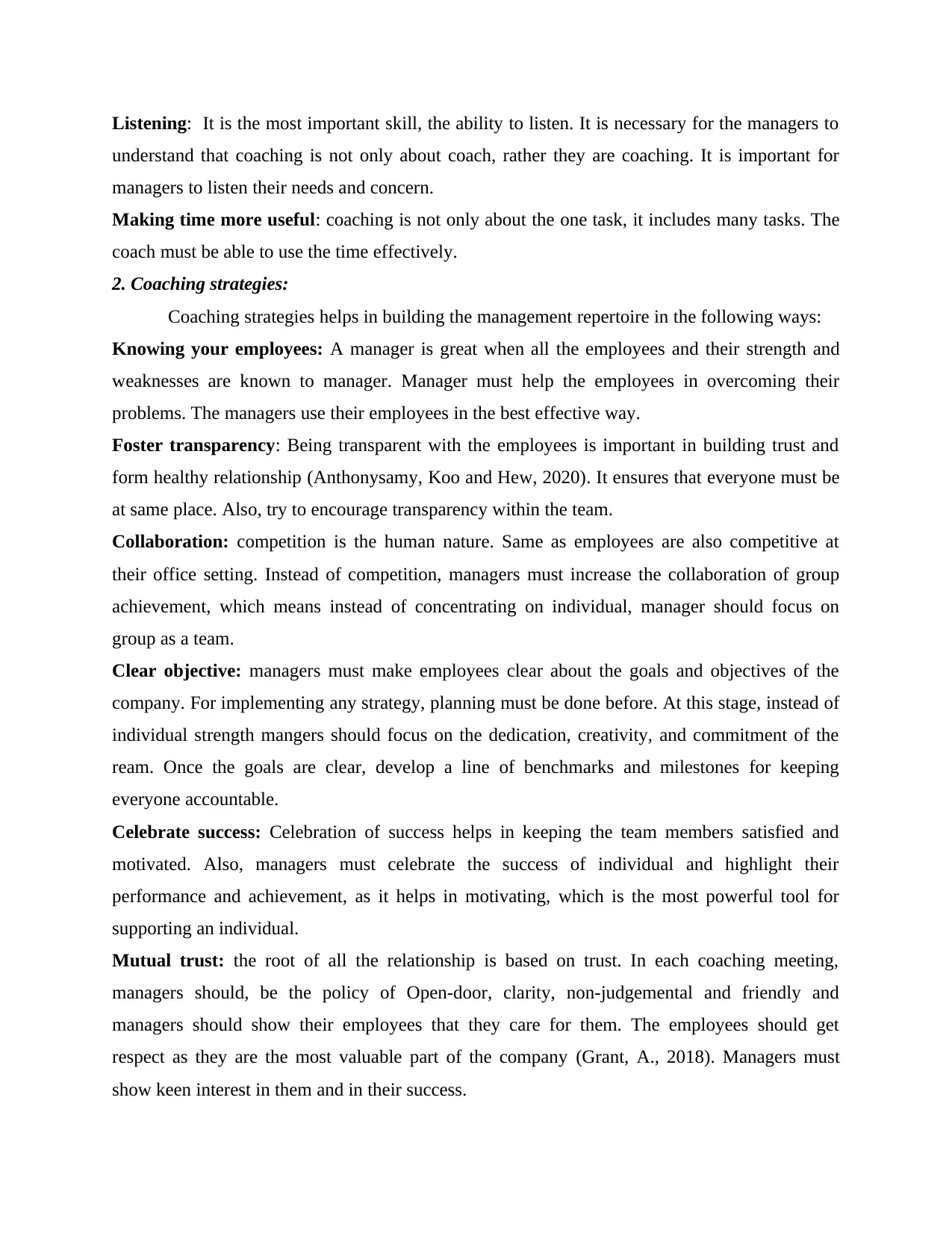
Listening: It is the most important skill, the ability to listen. It is necessary for the managers to
understand that coaching is not only about coach, rather they are coaching. It is important for
managers to listen their needs and concern.
Making time more useful: coaching is not only about the one task, it includes many tasks. The
coach must be able to use the time effectively.
2. Coaching strategies:
Coaching strategies helps in building the management repertoire in the following ways:
Knowing your employees: A manager is great when all the employees and their strength and
weaknesses are known to manager. Manager must help the employees in overcoming their
problems. The managers use their employees in the best effective way.
Foster transparency: Being transparent with the employees is important in building trust and
form healthy relationship (Anthonysamy, Koo and Hew, 2020). It ensures that everyone must be
at same place. Also, try to encourage transparency within the team.
Collaboration: competition is the human nature. Same as employees are also competitive at
their office setting. Instead of competition, managers must increase the collaboration of group
achievement, which means instead of concentrating on individual, manager should focus on
group as a team.
Clear objective: managers must make employees clear about the goals and objectives of the
company. For implementing any strategy, planning must be done before. At this stage, instead of
individual strength mangers should focus on the dedication, creativity, and commitment of the
ream. Once the goals are clear, develop a line of benchmarks and milestones for keeping
everyone accountable.
Celebrate success: Celebration of success helps in keeping the team members satisfied and
motivated. Also, managers must celebrate the success of individual and highlight their
performance and achievement, as it helps in motivating, which is the most powerful tool for
supporting an individual.
Mutual trust: the root of all the relationship is based on trust. In each coaching meeting,
managers should, be the policy of Open-door, clarity, non-judgemental and friendly and
managers should show their employees that they care for them. The employees should get
respect as they are the most valuable part of the company (Grant, A., 2018). Managers must
show keen interest in them and in their success.
understand that coaching is not only about coach, rather they are coaching. It is important for
managers to listen their needs and concern.
Making time more useful: coaching is not only about the one task, it includes many tasks. The
coach must be able to use the time effectively.
2. Coaching strategies:
Coaching strategies helps in building the management repertoire in the following ways:
Knowing your employees: A manager is great when all the employees and their strength and
weaknesses are known to manager. Manager must help the employees in overcoming their
problems. The managers use their employees in the best effective way.
Foster transparency: Being transparent with the employees is important in building trust and
form healthy relationship (Anthonysamy, Koo and Hew, 2020). It ensures that everyone must be
at same place. Also, try to encourage transparency within the team.
Collaboration: competition is the human nature. Same as employees are also competitive at
their office setting. Instead of competition, managers must increase the collaboration of group
achievement, which means instead of concentrating on individual, manager should focus on
group as a team.
Clear objective: managers must make employees clear about the goals and objectives of the
company. For implementing any strategy, planning must be done before. At this stage, instead of
individual strength mangers should focus on the dedication, creativity, and commitment of the
ream. Once the goals are clear, develop a line of benchmarks and milestones for keeping
everyone accountable.
Celebrate success: Celebration of success helps in keeping the team members satisfied and
motivated. Also, managers must celebrate the success of individual and highlight their
performance and achievement, as it helps in motivating, which is the most powerful tool for
supporting an individual.
Mutual trust: the root of all the relationship is based on trust. In each coaching meeting,
managers should, be the policy of Open-door, clarity, non-judgemental and friendly and
managers should show their employees that they care for them. The employees should get
respect as they are the most valuable part of the company (Grant, A., 2018). Managers must
show keen interest in them and in their success.
⊘ This is a preview!⊘
Do you want full access?
Subscribe today to unlock all pages.

Trusted by 1+ million students worldwide
1 out of 18
Related Documents
Your All-in-One AI-Powered Toolkit for Academic Success.
+13062052269
info@desklib.com
Available 24*7 on WhatsApp / Email
![[object Object]](/_next/static/media/star-bottom.7253800d.svg)
Unlock your academic potential
Copyright © 2020–2025 A2Z Services. All Rights Reserved. Developed and managed by ZUCOL.





